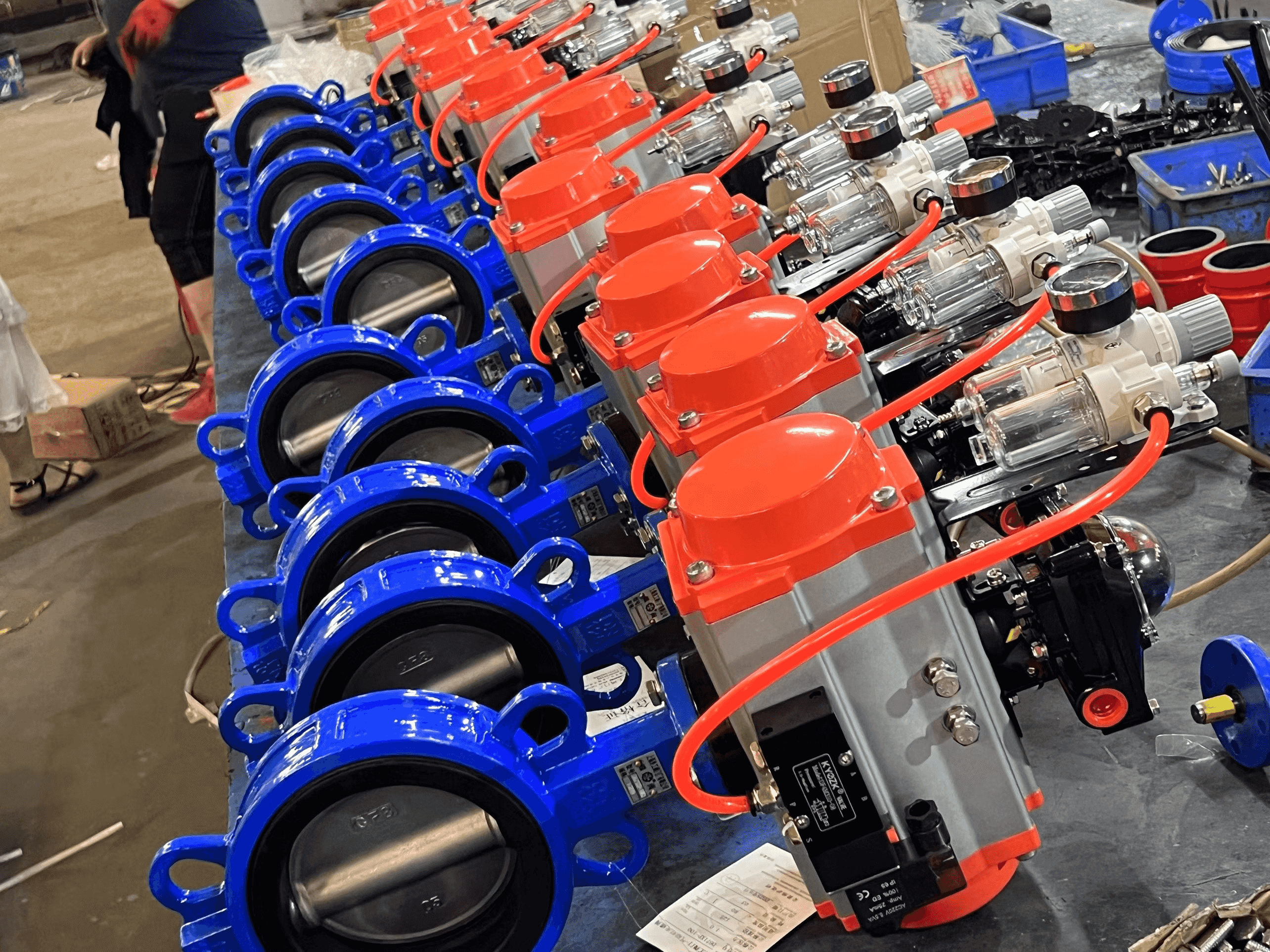공압 밸브 작동 원리: 산업 자동화의 핵심 메커니즘
압축 공기를 통한 작동: 공압 밸브 작동의 기초
공압 밸브는 압축 공기 동력을 시스템 내에서 유체의 흐름을 제어하는 실제 운동으로 변환시켜 작동합니다. 기본 원리는 간단한데, 공기 압력이 액추에이터 부품에 작용할 때(일반적으로 제곱인치당 3~15파운드 사이) 피스톤이나 내부의 유연한 다이어프램을 밀게 됩니다. 이는 밸브의 종류에 따라 직선 운동 또는 회전 작용을 생성합니다. 이러한 밸브의 특징은 속도입니다. 대부분의 공압 시스템은 1초 미만의 시간 내에 반응할 수 있어 정밀 조정이 지속적으로 이루어지고 하루 종일 빠른 변경이 필요한 공장에서 널리 사용됩니다.
주요 구성 요소: 액추에이터, 포지셔너 및 제어 요소
세 개의 핵심 하위 시스템이 밸브 작동의 정확성을 보장합니다:
- 액츄에이터 : 공기 압력을 기계적 힘으로 변환
- 포지셔너 : 밸브의 실제 위치를 제어 신호와 비교하고 ±0.5% 정확도로 편차를 교정
- 제어 요소 : 액추에이터 작동에 따라 유량을 조절하는 밸브 플러그, 시트 및 스템을 포함함
이러한 구성 요소들이 함께 작동하여 다양한 산업 응용 분야에서 정확하고 신뢰성 있는 유량 제어가 가능하다.
정밀 유량 조절에서의 압력 차의 역할
밸브 부품 간의 제어된 압력 기울기는 공압 시스템이 98% 반복성을 갖는 유량을 달성할 수 있게 한다. 상류 압력이 증가하면 액추에이터 힘이 커지고, 하류 센서는 실시간 피드백을 제공하여 폐쇄 루프 제어를 가능하게 한다. 이는 화학 약품 계량 및 가스 혼합과 같은 정밀도가 요구되는 응용 분야에서 필수적이다.
전기 및 유압 액추에이션 시스템과의 비교
공압 밸브는 스파크를 일으킬 수 있는 전기가 사용되지 않기 때문에 가연성 물질 주변에서 사용하는 데 본질적으로 더 안전합니다. 유압 시스템과 비교했을 때 이러한 밸브는 작동 속도도 훨씬 빠릅니다. 테스트 결과에 따르면 사이클 시간이 기존 시스템의 약 절반에 불과하며, 유체 누출로 인한 위험 요소를 걱정할 필요도 없습니다. 구조 자체가 부품들이 시간이 지남에 따라 마모되는 부분이 적어 유지보수 비용을 절감하는 데 도움이 됩니다. 또한 제조사에서는 부식에 강한 소재를 사용하는 경우가 많아 밸브가 수리가 필요한 시점까지 오래 사용할 수 있습니다. 업계 보고서에 따르면 전기 액추에이터에 비해 유지보수 비용이 30~40% 감소하는 것으로 나타났으며, 이는 장기적으로 안전과 운영 비용 모두를 고려하는 시설에 있어 현명한 투자 수단이 될 수 있습니다.
악 harsh한 산업 환경에서의 신뢰성과 내구성
공압 밸브 시스템은 극한의 환경 스트레스 요인 하에서도 일관된 성능을 유지합니다. 견고한 설계는 다른 구동 기술이 성능 저하가 발생하는 환경에서도 운전의 지속성을 보장하므로, 연속적인 산업 공정에 필수적입니다.
극한 온도, 부식, 먼지 및 진동 환경에서의 성능
공압 밸브는 영하 40도에서 섭씨 150도까지 넓은 온도 범위에서 잘 작동합니다. 화학 부식이나 먼지 유입, 심지어 심한 진동에도 비교적 잘 견딥니다. 2024년 재료 적합성 연구 그룹의 연구자들에 따르면, 철강 공장과 같이 산화철이 다량 발생하는 환경에서 공압 시스템은 전기 액추에이터에 비해 약 84%의 고장을 줄일 수 있습니다. 해상 석유 시추 장비와 같은 환경에서는 제조업체들이 비철금속과 PTFE 씰을 자주 사용하는데, 이는 장비에 손상을 줄 수 있는 염수 스프레이와 유해한 탄화수소 냄새를 막는 데 효과적입니다.
장기 내구성: 석유 및 가스 처리 공장 사례 연구
중동 지역의 유전 정제소에서 실시된 15년간의 현장 연구에 따르면, 공압 밸브는 주변 온도가 섭씨 55도를 넘는 혹독한 환경에서도 95% 이상의 가동 시간을 달성했으며, 부품 고장률은 2% 미만이었습니다. 이러한 성능은 특히 자주 발생하는 모래폭풍이 있는 사막 조건에 맞춰 설계된 강화된 스테인리스 스틸 액추에이터와 중복 밀봉 시스템 덕분이었습니다.
기타 시스템 대비 낮은 유지보수 요구도
먼지가 많은 환경에서 공압 시스템은 전기 액추에이터보다 유지보수 작업이 40% 적게 필요합니다. 전기 접점이 없어 마모되지 않으며, 자체 청소 기능이 있는 스풀 밸브 설계로 인해 정비 주기는 일반적으로 3~5년까지 연장되며, 이는 채광 작업장에서 유압 시스템이 요구하는 6~12개월의 정비 주기와 비교해 매우 긴 편입니다.
까다로운 환경 에서 회복력 을 향상 시키는 디자인 특성
주요 견고성 기능은 다음과 같습니다.
- 파일럿 밸브의 마모를 줄이는 진동 저감 마운트
- 신속한 부품 교체를 위한 모듈식 카트리지 설계
- 실리카 먼지로부터 내부 기구를 보호하는 다층 여과 시스템
- 건조한 환경에서도 밀봉 무결성을 유지하는 사전 윤활 실린더
이러한 설계 요소들은 마모성 조건에 장기간 노출된 이후에도 압력 경계 부품에 대한 ASME B16.34 표준 준수를 보장합니다.
동적 유량 조절을 위한 정밀 제어 및 빠른 반응
유량 제어 응용 분야에서의 고속 작동 및 정확성
최적화된 공기 통로와 저마찰 밀봉 덕분에 최신 기종의 공압 밸브는 50밀리초 이하의 반응 시간을 달성합니다. 이러한 속도는 포장 라인 및 반도체 제조와 같이 고속 작동이 생산 효율성에 직접적인 영향을 미치는 고주기 응용 분야에서 정밀한 유량 조절을 가능하게 합니다.
동적 변조를 위한 고급 공압 액추에이터 설계
엔지니어들은 이제 포펫 밸브를 피로트 작동 다이어프램과 결합하여 ±1%의 정확도를 유지하면서 최대 8,000 SCFM의 유량을 관리합니다. 이러한 구성은 플라스틱 사출 성형 및 식품 등급 가스 블렌딩과 같은 공정에서 필수적인 실시간 압력 조정을 지원합니다.
디지털 포지셔너 및 실시간 피드백 시스템과의 통합
2023년 자동화 산업 설문조사에 따르면 신규 공압 밸브 설치의 78% 이상에 IoT 연결 기능이 있는 디지털 포지셔너가 포함되고 있습니다. 이러한 스마트 시스템은 원격 교정, 실시간 상태 모니터링, 수동 조정 감소를 통해 정수 처리 시설의 노동력 요구를 40%까지 줄일 수 있습니다.
폐루프 제어 및 스마트 진단을 통한 정밀도 향상
고급 제어 알고리즘이 초당 200개 이상의 데이터 포인트를 처리하여 최적의 유량을 유지하고, 온도 변화 및 마모에 대해 자동으로 보상합니다. 내장 진단 기능을 통해 다이어프램 고장을 최대 72시간 전에 예측할 수 있어 제약 생산 환경에서 예기치 못한 가동 중단을 63% 줄일 수 있습니다.
위험한 산업용 사용을 위한 본질적 안전 및 페일세이프 설계
가연성 환경에서의 폭발 보호 규정 준수 (ATEX, IECEx)
연료 처리 시설 및 화학 물질 제조 현장과 같이 가연성 가스나 증기가 머무는 장소에서는 ATEX 및 IECEx 표준을 충족하는 공압 밸브가 매우 중요한 역할을 합니다. 이러한 밸브는 스파크로 인한 화재를 방지하도록 설계되었으며, 특수한 공기 차단형 액추에이터와 혹독한 조건에서도 스파크를 발생시키지 않는 소재를 채택하고 있습니다. 그 결과, 폭발이 발생할 수 있는 환경에서도 훨씬 더 안전한 작업이 가능해집니다. 지난해 'Process Safety and Environmental Protection' 저널에 발표된 최근 안전 평가에 따르면, 이러한 인증 시스템을 사용하는 시설에서는 가장 위험한 지역 내 화재 사고가 약 3분의 2 수준으로 감소한 것으로 나타났습니다.
고장 안전 메커니즘: 스프링 귀환 및 비상 정지 기능
스프링 리턴 액추에이터는 전원이 끊기거나 압력이 실패할 때 밸브를 안전한 위치로 자동으로 복귀시킵니다. 이중화된 차단 회로는 위험한 공정을 즉시 격리하여 ISO 13849 성능 수준 요구사항을 준수합니다. 전기식 유지 시스템과 달리 공압식 페일세이프는 지속적인 에너지 공급이 필요하지 않아 비상 상황에서 신뢰성을 높일 수 있습니다.
화학 및 석유화학 공정에서의 안전성 이점
유럽 전역의 12개 정유소에서 수행된 연구에 따르면, 폐쇄 루프 공압 시스템은 전통적인 유압 장치에 비해 산을 취급할 때 위험한 누출을 약 42% 줄이는 것으로 나타났습니다. 저 많은 유압 작동유가 움직이지 않기 때문에 화재의 연료가 될 것도 없습니다. 또한, 그 특수 고분자 씰은 염소나 황화수소와 같은 극심한 환경에서도 분해되지 않고 견딥니다. 2022년 곤잘레스-코르테스(Gonzalez-Cortes) 연구팀에 의해 '공정 안전 및 환경 보호(Process Safety and Environmental Protection)' 저널에 발표된 최근 논문도 이를 뒷받침하고 있습니다. 이 연구는 밀폐된 공간에서 이러한 공압 시스템을 작업하는 것이 전기 액추에이터를 다루는 것보다 실제로 58% 더 안전하다는 것을 입증했습니다. 생각해보면 당연한 일이죠.
공압 밸브 시스템의 경제성과 에너지 효율성
낮은 총 보유 비용: 유지보수, 에너지, 수명 주기 분석
산업 응용 분야에서 공압 시스템은 전기 시스템 대비 23% 낮은 수명 주기 비용을 보인다(International Energy Agency, 2024). 공기를 이용한 작동 방식은 습한 환경에서 전기 고장을 방지하여 밸브당 연간 유지보수 비용을 18달러 절감한다. 화학 공장 대상 5년간의 분석 결과에 따르면 유압 시스템 대비 예비 부품 교체가 40% 적은 것으로 나타났다.
지능형 압축 공기 관리를 통한 에너지 효율 최적화
공압 설계의 혁신으로 공기 소비량을 34% 줄임:
- 내부 누설을 최소화하는 정밀 가공된 스풀
- 제어 공기 사용량을 50% 줄이는 피스톤 조작 액추에이터
- 공정 수요에 따라 밸브 작동 시점을 최적화하는 스마트 컨트롤러
이러한 개선 사항은 ISO 50001 규정 준수를 지원하며 생산 라인당 연간 최대 7,200달러를 절약할 수 있다(ASME 에너지 감사 가이드라인, 2023).
| 시스템 유형 | 연간 에너지 비용 | 연간 유지보수 시간 | 면적(평방피트) |
|---|---|---|---|
| 공기 | $4,200 | 12 | 8.5 |
| 전기 | $6,800 | 28 | 11.2 |
| 유압 | $9,500 | 45 | 18.7 |
공압식 대 전기 액추에이터: 종합적인 비용 및 성능 비교
전기 액추에이터는 제어된 환경에서 더 높은 정밀도(±0.05% vs ±0.15%)를 제공하지만, 산업 현장에서는 공압식의 신뢰성이 우수하다. 제철소에서 공압 밸브는 전기 시스템의 91.2%에 비해 98.7%의 가동 시간을 유지하는데, 이는 전자기 간섭에 대한 저항력 덕분이다(산업 자동화 분기별 보고서 2024).
공압식 대 유압 시스템: 효율성, 공간 점유율 및 운영 비용
공압 시스템은 유압 장치에 비해 60% 적은 공간을 차지하면서도 최대 3,500 psi의 동등한 힘을 제공한다. 오일이 필요 없는 작동 방식은 유압 시스템에서 흔히 발생하는 연간 약 14,000달러의 유체 교체 및 필터링 비용을 절감할 수 있다(유체 동력 협회 보고서 2024).
예지 정비 및 산업 4.0 준비를 위한 스마트 통합
IoT 센서가 장착된 현대식 공압 밸브는 수동 점검보다 공기 누출을 83% 더 빠르게 감지합니다. 이러한 예측 기능은 자동차 어셈블리 공장에서 예기치 못한 다운타임을 42% 줄이며, 서비스 수명을 평균 19개월 연장합니다(Smart Manufacturing Journal, 2024).
자주 묻는 질문
공압 밸브가 가연성 환경에 적합한 이유는 무엇입니까?
공압 밸브는 전기를 사용하지 않기 때문에 가연성 물질을 점화할 수 있는 스파크 위험이 줄어듭니다. 이는 ATEX 및 IECEx와 같은 폭발 보호 관련 특정 규격을 충족합니다.
공압 밸브는 유압 및 전기 시스템과 속도 측면에서 어떻게 비교되나요?
공압 밸브는 유압 시스템보다 일반적으로 더 빠르게 작동하며, 사이클 시간은 전통적인 시스템의 약 절반 수준입니다. 또한 빠른 작동 속도를 제공하여 종종 1초 미만의 반응 시간을 가지므로 동적 산업 프로세스에 이상적입니다.
공압 시스템은 극한의 환경 조건을 어떻게 처리합니까?
공기압 시스템은 극한의 온도, 부식, 먼지 및 진동에 견딜 수 있도록 설계되었습니다. 진동을 줄이는 마운트 및 사전 윤활 실린더와 같은 내구성 있는 소재와 설계 요소로 인해 특히 혹독한 환경에서도 매우 신뢰성이 높습니다.
공기압 시스템의 유지보수상 이점은 무엇입니까?
공기압 시스템은 전기식 및 유압 시스템에 비해 유지보수 작업이 적게 필요합니다. 자체 청소 기능이 있는 스풀 밸브 설계 및 전기 접점이 없는 구조는 서비스 주기를 상당히 연장하여 전체적인 유지보수 비용을 절감합니다.
다른 시스템에 비해 공기압 밸브가 더 경제적인가요?
네, 공기압 시스템은 전기식 및 유압식 대안에 비해 수명 주기 비용이 낮고 유지보수 비용이 적으며 에너지 효율성이 향상되었습니다. 또한 바닥 공간을 덜 차지하며 유압 시스템에서 흔히 발생하는 유체 교체 및 필터 교환에 드는 비용을 피할 수 있습니다.



